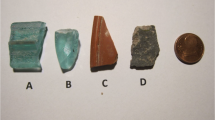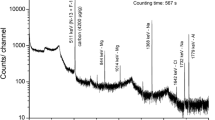Abstract
12 MeV proton activation analysis is applied to a variety of archaeological specimens (glass, pottery, mortar and ivory) and its usefulness studied. The method is non-destructive and Ca, Ti, V, Cr, Fe, Cu, Zn, As, Sr, Y, Zr and Sb, ranging from percentage to parts per million (ppm) level were determined. The detection limits in archaeological glass for Ti, V, Cr, Fe, As, Sr, Y and Zr are at 1–10 ppm level; Cu, Zn and Sb at 20–35 ppm level, and Ca at 150 ppm level.



Similar content being viewed by others
References
Barrondon JN, Callu JP, Brenot C (1977) The analysis of Constantin coins (A.D. 313-40) by non-destructive Californium 252 activation analysis. Archaeometry 19:173–186
Hoffmann P, Vetter G (1990) Analytical examination of mortars from the medieval derelict village Holzheim. Fresenius J Anal Chem 338:133–137
Mommsen H, Hein A, Hähnel E (1997) Classification of medieval ceramics in the Rhineland and neighbouring areas by neutron activation analysis. J Radioanal Nucl Chem 216:247–252
Drauschke J, Greiff S (2010) Early Byzantine glass from Caričin Grad/Iustiniana Prima (Serbia): first results concerning the composition of raw glass chunks. In: B. Zorn u. A. Hilgner (Hrsg.), Glass along the Silk Road from 200 BC to 1000 AD. Tagungen des RGZM 9 (Mainz), pp. 53–67. Verlag des Römisch-Germanischen Zentralmuseum, Mainz (ISBN 978-3-88467-148-1)
Pollard AM, Batt CM, Stern B, Young SMM (2007) Analytical chemistry in archaeology. Cambridge University Press, UK
Müller K, Reiche I (2011) Differentiation of archaeological ivory and bone materials by micro-PIXE/PIGE with emphasis on two upper Paleolithic key sites: Abri Pataud and Isturitz, France. J Archaeol Sci 38:3234–3243
Freestone IC (2007) Application and potential of Electron Probe Micro Analysis in technological and provenance investigations of ancient ceramics. Archaeometry 24:99–116
Barone G, Mazzoleni P, Aquilia A, Barbera G (2014) The Hellenistic and Roman Syracuse (Sicily) fine pottery pottery production explored by chemical and petrographic analysis. Archaeometry 56:70–87
Hunt AMW, Dvoracek D, Glascock MD, Speakman RJ (2014) Major, minor and trace element mass fractions determined using ED-XRF, WD-XRF and INAA for three fireclay reference materials: c.137; c.138; and c.139. J Radioanal Nucl Chem 303:977–978. doi:10.1007/s10967-014-3365-x
Albert Ph, Chaudron G, Süe P (1953) Microdosage par voie chimique du carbone dans le fer irradie par le deutons. Bulletin de la Societie Chimique de France 20:97–102
Engelmann Ch (1971) Contribution a l`etude de la determination de Be, B, C, N, O et F par activation au moyen de p, d, 3He et α. J Radioanal Chem 7:89–101
Petri H, Sastri CS (1975) Oxygen determination in aluminium by Helium-3 activation analysis. Fresen Z Anal Chem 277:25–28
Sastri CS, Blondiaux G, Hoffmann P, Ortner HM, Petri H (2000) Oxygen determination in calcium fluoride by deuteron activation analysis. Fresenius J Anal Chem 366:218–220
Sastri CS, Blondiaux G, Petri H (1997) Trace determination of carbon, sodium, magnesium and aluminum in metals and ceramic materials by low energy deuteron activation analysis. Nucl Instrum Methods Phys Res B 124:558–566
Barthe MF, Giovagnoli A, Blondiaux G, Debrun JL, Tregoat Y, Barraud JY (1990) Fast analysis of oxygen in fluoride glasses (ZBLAN) by charged particle activation analysis (16O(d, n)17F). Nucl Instrum Methods Phys Res B45:105–106
Sastri CS, Blondiaux G, Petri H, Michulitz M (2000) Stoichiometric determination of carbon in ceramic materials by low energy deuteron activation analysis. J Radioanal Nucl Chem 244:457–462
Krivan V, Swindle DL, Schweikert EA (1974) Nondestructive determination of some trace elements in tantalum by proton activation analysis. Anal Chem 46:1626–1629
Sastri CS, Petri H, Erdtmann G (1977) Determination of 13 elements with atomic numbers between 12 and 47 by 14-MeV Helium-3 activation analysis. Anal Chem 49:1510–1513
Lacroix O, Sauvage T, Blondiaux G, Guinard L (1997) Ultra thin layer activation by recoil implantation of radioactive heavy ions; applicability in wear and corrosion studies. Nucl Instrum Methods Phys Res B 122:262–268
Vandecasteele C (1988) Activation analysis with charged particles. Ellis Horwood Limited, Chichester
Ishii K, Valladon M, Debrun JL (1978) The average stopping power method for accurate charged particle analysis. Nucl Instrum Methods 150:213–219
Ishii K, Valladon M, Sastri CS, Debrun JL (1978) Accurate charged particle activation analysis: calculation of the average energy in the average stopping power method. Nucl Instrum Methods 153:503–505
Debrun JL, Barrandon JN, Benaben P (1976) Irradiation of elements from Z = 3 to Z = 42 with 10 MeV protons and application to activation analysis. Anal Chem 48:167–172
Albert Ph, Blondiaux G, Debrun JL, Giovagnoli A, Valladon M (1987) Thick target yields for the production of radioisotopes, vol 273., Technical report seriesIAEA, Vienna
Zikovsky L, Schweikert EA (1977) Comparison of nondestructive proton and neutron activation: the case of biological samples. J Radioanal Chem 37:571–580
Guerra MF, Calligaro T (2004) Gold traces to trace gold. J Archaeol Sci 31:1199–1208
Hofmann G, Banerjee A (1994) “Wandmalereien aus einem roemischen Wohnhaus in Mainz: Naturwissenschaftliche Untersuchungen ueber den Aufbau der Putzschichten und die Zusammensetzung der Farbpigmente” in Mainzer Archaeologische Zeitschrift. Band 1, pp 211–227. Generaldirektion Kulturelles Erbe Rheinland-Pfalz. (ISBN 3-8053-2271-2)
Banerjee A, Bortalaso G, Dindorf W (2008) Distinction between African and Asian ivory. Bundesamt für Naturschutz, Bonn, pp 37–49
Sastri CS, Banerjee A, Sauvage T, Courtois B, Schuhmacher T (2013) Fluorine determination in different types of ivory by PIGE technique. J Radioanal Nucl Chem 298:311–315
Ziegler JF, Ziegler MD, Biersack JP (2008) The stopping and range of ions in matter, Version SRIM-2008.04, http://www.srim.org
Chu SYF, Ekström LP, Firestone RB (1999) The Lund/LBNL nuclear data search, Version 2.0, http://www.nucleardata.nuclear.lu.se/toi/
Ricci E, Hahn RL (1967) Sensitivities for activation analysis of 15 light elements with 18 MeV Helium-3 particles. Anal Chem 39:794–797
Rosenow D, Rehren Th (2014) Herding cats: Roman to late antique glass groups from Bubastis, northern Egypt. J Archaeol Sci 49:170–184
Riedel N (2007) “Provinzialrömische Wandmalerei in Deutschland“: Thesis. Universität Bamberg, Germany
Deconninck G (1978) Introduction to radioanalytical physics. Elsevier, Amsterdam
Neelmeijer C, Mäder M (2004) Reverse painting on glass as seen by the proton beam. Nucl Instrum Methods Phys Res, Sect B 226:126–135
Degryse P, Schneider J, Poblome J, Waelkens M, Haack U, Muchez P (2005) A geochemical study of Roman to early Byzantine glass from Sagalassos, South-west Turkey. J Archaeol Sci 32:287–299
Foster HE, Jackson CM (2010) The composition of late Romano-British colourless vessel glass: glass production and consumption. J Archaeol Sci 37:3068–3080
Takeuchi T, Nakano Y, Koike H (1998) Neutron activation analysis of ivory of African elephants. J Radiochem Nucl Chem 235:273–277
Sastri CS, Caletka R, Krivan V (1981) Simultaneous determination of boron and lithium by charged particle activation analysis. Anal Chem 53:765–770
Sastri CS, Iyengar V, Blondiaux G, Sauvage T, Tessier Y (2002) Determination of boron by (p,α) reaction. J Radioanal Nucl Chem 254:53–56
Olivier C, Morland HJ (1992) Average stopping powers and the use of non-analyte spiking for the determination of phosphorous and sodium by PIPPS. J Radioanal Nucl Chem 160:211–219
Degryse P, Shortland J (2009) Trace elements in provenancing raw materials for Roman glass production. Geologica Belgica 12(3-4):135–143
Acknowledgments
The authors would like to thank Prof. M. Egg and Frau Dr. S. Greiff of Römisch-Germanisches Zentralmuseum, Mainz for supplying Roman ivory and Roman glass (pale blue) specimens, respectively. Special thanks are due to Frau Dr. B. Heide and Frau Dr. E. Riemer of Landesmuseum, Mainz (Abteilung: Archäologie), for supplying the Roman glass (dark blue) specimen.
Author information
Authors and Affiliations
Corresponding author
Rights and permissions
About this article
Cite this article
Sastri, C.S., Banerjee, A., Sauvage, T. et al. Application of 12 MeV proton activation to the analysis of archaeological specimens. J Radioanal Nucl Chem 308, 241–249 (2016). https://doi.org/10.1007/s10967-015-4313-0
Received:
Published:
Issue Date:
DOI: https://doi.org/10.1007/s10967-015-4313-0




